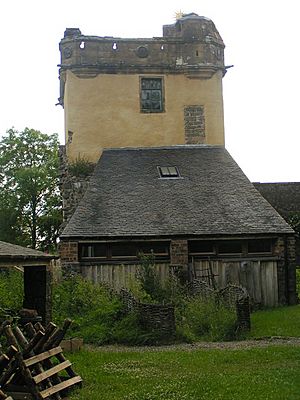Palace of Monimail facts for kids
The Palace of Monimail, also called Monimail Tower, was a grand old palace built in the Renaissance style. It was located in Fife, Scotland. For a long time, starting in the 1200s, it was a home for the Archbishops of St Andrews, who were important church leaders. Later, in the early 1600s, it became the main home for the Melville family. The title "Lord Monimail" is still used by the Leslie-Melville Earls of Leven. The palace was left empty in the late 1600s, and most of it was torn down. Today, only one tower is still standing. You can find it on the grounds of Melville House near the village of Monimail, about 4 kilometers (2.5 miles) north of Ladybank.
Contents
Why Monimail Was Built
Monimail Palace was built in a very good spot. It was where the main roads between St. Andrews, Perth, and Stirling met. It also looked out over the beautiful Howe of Fife valley. This made Monimail a very desirable property for the Bishops of St Andrews. Records show that the estate belonged to the bishop as early as 1206. Around 1319, William Lamberton, who was the Bishop of St. Andrews from 1298 to 1328, built a high-quality manor house here. He did this after the Battle of Bannockburn when things became more peaceful.
The Renaissance Palace Era
Many people used to believe that the famous Cardinal David Beaton (who lived from about 1494 to 1546) built the palace. However, newer studies suggest that his uncle, James Beaton (1473–1539), who was also an Archbishop of St Andrews before David, actually built it. During this time, Monimail was known as a "comfortable, quiet country home." It was big enough to host important people and their groups. Church records show that both James and David Beaton loved staying at Monimail, second only to their main residence in St Andrews. James Beaton even spent money to bring fruit trees from France to plant in the palace gardens!
After David Beaton was killed in 1546, other archbishops continued to use the palace. This lasted until the time of the Scottish Reformation, a big change in Scotland's church. In 1552, Archbishop John Hamilton (1512–1571) stayed at Monimail for several weeks. He was getting medical treatment from an Italian doctor named Jerome Cardan.
Mary, Queen of Scots visited the castle for dinner on March 23, 1563. However, she actually spent the night at Baillinbreich. In 1564, Archbishop Hamilton sold Monimail to Sir James Balfour of Pittendriech. By this time, most of the palace, except for the tower, was said to be falling apart. Balfour and his son worked to fix up the tower. Then, in 1592, they sold the estate to Sir Robert Melville of Murdocairnie.
The Palace's Decline
In the late 1690s, a descendant of Sir Robert, George Melville, 1st Earl of Melville (1636–1707), decided to build a new, fashionable mansion. He called it Melville House, and it was built in the Classical style on his Monimail estate. For many years, the old Monimail Palace ruins were kept as a beautiful "folly" in the park of the new house. A folly is a building built just for decoration. The tower of the palace was still in "pretty good preservation" as late as 1791. But in the 1820s, the Melville family built walled gardens. This changed the ground levels around the palace site, causing most of the remaining parts to be buried.
Monimail Tower Today
The tower that is still standing has three floors above a basement. The basement was later changed to become an ice house, which was used to store ice. The lower parts of the tower are likely from the original bishop's palace. However, the upper parts were rebuilt during the late 1500s. In 1993, an investigation found the buried remains of another corner tower and part of a connecting wall near Monimail Tower.
The artistic details on the tower, especially the Renaissance-style round carvings of faces on the top edge (called the parapet), are similar to those at the nearby Falkland Palace. The roundels at Monimail were probably made in the 1570s. For comparison, the ones at Falkland were made in the 1530s, and the famous wooden Stirling Heads are from around 1540.
In the 1990s and 2000s, the Monimail Tower Preservation Trust carefully restored the tower. They used materials that were historically correct to make it look as it did long ago. The gardens around the Tower are now home to a small group of people who live together in an intentional community.
The tower is a category A listed building. This means it is recognized as a very important building in Scotland.


